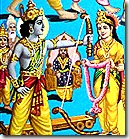 “The princes and their armies were beautiful, chivalrous, and of good age, family and birth, looking as if Indra had descended to earth and was marching towards Janakpur.” (Janaki Mangala, 9)
“The princes and their armies were beautiful, chivalrous, and of good age, family and birth, looking as if Indra had descended to earth and was marching towards Janakpur.” (Janaki Mangala, 9)rūpa sīla baya bansa birūda bala dala bhaye |
manahum̐ purandara nikara utari avanihiṃ cale ||
With an arranged marriage, the union that takes place is really between two families. The bride and groom hardly know one another beforehand, so to foretell whether or not the relationship will stand the test of time, the standings of the two families involved are assessed. If it has been proved in countless past generations that such marriages worked, that the character of the support system was properly suited to the time and circumstance, then there is an increased likelihood that the same characteristics will be passed on to the present day participants. Even if the values weren’t explicitly instilled, just growing up in a pious environment can do wonders. One actually teaches more with the example they set than with the words of instruction they offer. Man, being born ignorant, is always unsure of the right move to take. To settle doubts, others are observed, for if they follow a particular route and don’t get harmed by it, then there is less of a risk in following their example. One event in particular saw the noblest families from around the world ready to accept the daughter of a famous king, whose qualities were so sublime that he was respected in every land.
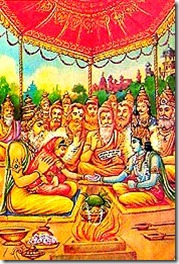
Why were there multiple families involved? As these events took place during the Treta Yuga, all marriages then were arranged by the parents. Not to be mistaken for an artificial way of suppressing the natural desires for romantic interaction, the marriages were arranged to stay in line with dharma. The Vedic term “dharma” can be translated to mean
religion
, but its root meaning is an essential characteristic. The dharma of fire is heat and light, of water wetness, of grass green color, and so on. As objects can have more than one property, that which is foremost becomes its dharma. There is also no question of something assuming a dharma or rejecting it. Dharma always stays with the object; it defines its existence.
For the living beings, their dharma is the penchant to serve. To know why this penchant exists, one must know their real identity. The soul is the identifying aspect within every life form, as the temporary coverings are just that: temporary. As shirts, pants and coats can be put on and taken off, so the gross collection of material elements can be accepted, manipulated, and then eventually discarded, with the identity of the individual remaining unchanged.
When these forms are accepted, the dharma of the individual gets covered up, sort of like putting a shade on a bright lamp. The existence of the soul never ceases, so the dharma is always there. Depending on the type of dress accepted, knowledge of that characteristic may be forgotten to varying degrees. If we have a knife and think that it should be used as a spoon or fork, obviously we will not be following the proper guidelines. The knife is very sharp for a reason. It is meant to cut things. If it is used as a utensil to place food in the mouth, there is every chance of the tongue being cut or some other accident happening which carries negative consequences.
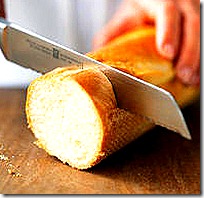
The spirit soul trapped in a material body similarly has a constitutional purpose. Through ignorance only the living being accepts their temporary forms to be their true identity. They see the gross collection of material elements on others to represent their identities as well. Sex life is based entirely on this illusion. We see someone of the opposite sex and measure their attractiveness based on their outward features, but what we don’t see is that they are a spirit soul at the core. Their collection of blood, pus and mucus will gradually morph over the years to the point that they may cease to be attractive, but their identity will not change throughout the process.
What is the harm in succumbing to this illusion? Just as the knife is meant to cut, the soul is meant to serve. That service is meant for a higher entity, one who is not illusioned by the material elements. Through these truths, we get one definition of God and His standing. God is just our word to describe Him, but He can also be referred to as the Supreme Soul, for He is spirit just like us but without a tendency towards ignorance. The human life is considered the most valuable because it carries with it the potential to develop consciousness to the point that the proper identity of the individual and the proper set of activities, namely the directing of the service mentality toward the appropriate area, can be revealed.
From this information, the ultimate mission in life becomes discernable. Dharma accepts an additional definition: a type of maintenance system having guiding principles, where regulations are instilled that help the individual understand the mission in life and achieve it. It is not that everyone will be open to immediately accepting all the truths of spiritual life passed on by the Vedas. Therefore there are scales of dharma, meant to target the varying levels of intelligence. The idea is that by following the more streamlined systems of regulation, one can gradually ascend the chain of knowledge. This ascendency continues even into the next life. Therefore, should someone never learn about the soul in this life, if they follow the prescribed regulations for their order, which is their occupational duty tied to their behavioral characteristics, they can find themselves in a better position in the next life.
The next life is simply a new demarcation of time. We could even think of each new day as a new life, for the time continuum hasn’t changed with the rising of the sun in the morning; only our perspective on the timeline changes. Since time is continuous, even within one’s lifetime the same spiritual advancement can be made. Illusion is the largest stumbling block towards assuming one’s real dharma. Illusion’s strongest force is sex life, especially the kind which is not based on religious principles. Therefore ideally from the very beginning, when children are young, the tendency towards
illicit sex
is checked by the parents through the marriage institution.
“I am the strength of the strong, devoid of passion and desire. I am sex life which is not contrary to religious principles, O Lord of the Bharatas [Arjuna].” (Lord Krishna,
Bhagavad-gita
, 7.11)

In ancient times, the pious kings were especially conscious of the need to marry off their daughters when they reached the appropriate age. If you have an abundance of unmarried women in society, illicit sex will result. From illicit sex comes an unwanted and unloved population. From lack of loving attention comes a society full of rogues who have no culture in even the basic standards of decency. The women get exploited through this system as well, for the men can easily get sex from them and not be responsible for their welfare.
The ancient marriages weren’t that complicated to arrange. You get an expert brahmana, or priest, and have them review the child’s astrological signs from the exact time of their birth. The constellation of stars at any particular given moment can be either auspicious or inauspicious. Any person taking birth at one of these times can thus have their future predicted, including what type of character they will grow up to have. From the different characteristics ascertained, matches would be made. It wasn’t that just any boy and girl were suitable matches for marriage. The arrangement had to be “in the cards” so to speak, astrologically compatible.
One king faced a dilemma in this area. He had a most precious daughter, who was so beautiful, kind, sweet, compassionate and virtuous that the king didn’t want to let her go. The daughter essentially accepts a new family after marriage, leaving her father and his family bereft of her association. This daughter was special because the king had been childless prior to her appearance. She was considered the greatest fortune in his life, because she appeared from nowhere to give him and his family tremendous happiness.
This young girl wasn’t the king’s biological daughter. He had found her one day while ploughing a field. Thinking it was appropriate to protect and take care of her, the king really wanted to take her home and raise her as his daughter. As if the higher authorities read his mind, a voice in the sky appeared on the scene and told the king that this girl was indeed his daughter in all righteousness. The first issue was now resolved. The king could take the girl home and raise her as his daughter.
She proved to be a perfect fit in his family. The king’s name was Janaka, and he was one in a long line of pious rulers named Janaka. This Janaka was especially devoted to dharma and was famous throughout the world for being above the influence of the senses. Though he was married and ruling over a kingdom, he was not attached to any of his duties. He met every obligation as a matter of protocol, not caring for the result one way or the other. These are the godly principles, which are even lauded by
Lord Krishna
in the Bhagavad-gita.
“Therefore, without being attached to the fruits of activities, one should act as a matter of duty; for by working without attachment, one attains the Supreme.” (Lord Krishna, Bg. 3.19)
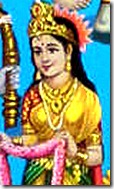
The daughter was named Sita because she came out of the ground, not having biological parents. When it was time for Sita’s marriage, Janaka was torn inside. He felt like a wealthy man about to become poor, for the goddess of fortune was going to leave his family. Sita was really Lakshmi Devi appearing on earth to take part in the pastimes of the Supreme Lord, who had appeared as
Lord Rama
in the family of the Raghus. Janaka knew none of this, but he didn’t need to. From her qualities he could tell that Sita was special.
In addition to the trepidation over losing Sita, Janaka faced another problem. He didn’t know who Sita’s parents were, nor did he know the astrological signs from the time of her birth. Therefore how could he find a suitable match for her? Yet if he kept Sita unmarried, he would invite scorn from his family members and also the community that he vowed to protect. If the king could keep his daughter unmarried, why shouldn’t everyone else then follow the same example?
After consulting with his priests and family members, the king arrived on a compromise. He had been given an amazing bow belonging to Lord Shiva, the worshipable figure of the Vedic tradition charged with destroying the creation at the appropriate time. The bow was so heavy that it seemed impossible to lift. Janaka vowed that if any prince from around the world could lift it, they would get Sita’s hand in marriage. Through their strength they would prove to be the fittest man capable of protecting his beloved daughter.
The announcement of the king’s vow went out across every country. The news was so happily accepted that royal clans gathered their things and made the trek to Janakpur, Janaka’s city where the contest was being held. In the above referenced verse from the
Janaki Mangala, Goswami
Tulsidas
says that the procession of the armies was so amazing that it looked like Lord Indra had descended to earth and was marching towards Janakpur. Indra is the king of the heavenly planets, where the residents live longer and more materially enriched lives. Indra is also responsible for fighting against the evil elements of the world. Since the beginning of time the devoted class, the
suras, and the non-devoted, the
asuras, have clashed. Indra is the most powerful of the
demigods
; hence he is their leader. His royal army resembles no other; therefore the comparison was appropriate.
It is also said that the princes arriving were beautiful and chivalrous, or disciplined. Sita was the most beautiful woman in the world, so a beautiful prince would be a fit match. She was also Janaka’s daughter, which meant that her level of piety was extremely high. Though Sita wasn’t formally educated, her knowledge of the Vedas was outstanding, as she observed the Vedic rites and rituals conducted in her father’s kingdom while growing up. Simply through listening to the words of her parents and the brahmanas, she acquired high knowledge.
The princes coming to Janakpur were also of a good age, family and ancestry. Lord Shiva’s bow would not be easy to lift. It would take more than just brute strength to raise it. One had to have a good family background, where they were trained properly in the military arts. The bow belonged to
Lord Shiva
, and it was obviously heavy for a reason. A prince had to be of the proper age to try to lift the bow. Men who are of the proper age for marriage typically have the highest levels of strength they will have in their life. Even in sports, it is seen that there is a typical age when the athlete’s performance is at its peak. If they are too young, they may have a lot of energy but not enough strength or dexterity. If the athlete is too old, they may no longer have the strength and coordination to compete at the highest levels. These princes arriving were of just the right age.
The princes were of a good family and came from good ancestry. It would seem like these things shouldn’t have mattered, but to marry the daughter of King Janaka, one had to come from a good dynasty, for the two families would be united through the marriage. The description of the armies arriving serves as a reminder that the most respected royal families came to Janakpur for the contest, showing how much Janaka was favored and how coveted Sita’s hand in marriage was. A prince coming from a good dynasty and having a link to many famous kings from the past obviously will not want to marry just any princess. The girl should come from a family equally as respected, if not more so.
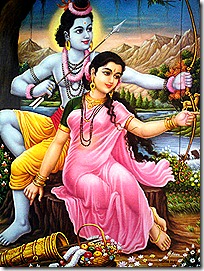
The scene in Janakpur that fateful day was legendary. While many of the most respected and capable princes came to try to win Sita’s hand in marriage, just as the living entities have a particular dharma, so do the Lord’s closest associates. Sita is God’s eternal consort, which means that she can never be with any man except the Supreme Lord. During this time on earth, the external events were manipulated in just the right way so as to allow the goddess of fortune’s husband to arrive on the scene and win her hand in marriage. Lord Rama, though not part of the giant procession of armies, would arrive nonetheless, coming without any fanfare or pomp. He would come as the guest of the sage Vishvamitra, who was travelling the forests at the time, with Rama and His younger brother
Lakshmana
acting as his protection.
Though they didn’t come to Janakpur for the purpose of participating in the contest, Janaka was so invigorated by the vision of the two brothers that he allowed Rama to make an attempt anyway. At Vishvamitra’s request, Rama would step up, raise Shiva’s bow, and be garlanded by Sita as the victor. His family, ancestry, beauty and chivalry were unmatched, for He is the Supreme Lord that never ceases to be the most fortunate living entity in the world. He proved His worthiness to have Sita as a wife on that day. All the famous kings and princes from around the world were there to witness the history, the marriage of Sita and Rama, which is still talked about, honored, worshiped, and remembered to this day.
In Closing:
From countries spread out far and wide,
Massive armies to Janakpur arrived.
Having tremendous chivalry and beauty,
And belonging to most famous ancestry,
The princes for king’s daughter hand did vie,
For an elegant princess each was qualified.
Like Indra leading the demigods scene did appear,
But only man to wed Sita, the remover of fear.
Dasharatha's son proved His worth by bow's lift,
That treasurable moment the sincere heart's gift.
 “The princes and their armies were beautiful, chivalrous, and of good age, family and birth, looking as if Indra had descended to earth and was marching towards Janakpur.” (Janaki Mangala, 9)
“The princes and their armies were beautiful, chivalrous, and of good age, family and birth, looking as if Indra had descended to earth and was marching towards Janakpur.” (Janaki Mangala, 9) Why were there multiple families involved? As these events took place during the Treta Yuga, all marriages then were arranged by the parents. Not to be mistaken for an artificial way of suppressing the natural desires for romantic interaction, the marriages were arranged to stay in line with dharma. The Vedic term “dharma” can be translated to mean
Why were there multiple families involved? As these events took place during the Treta Yuga, all marriages then were arranged by the parents. Not to be mistaken for an artificial way of suppressing the natural desires for romantic interaction, the marriages were arranged to stay in line with dharma. The Vedic term “dharma” can be translated to mean  The spirit soul trapped in a material body similarly has a constitutional purpose. Through ignorance only the living being accepts their temporary forms to be their true identity. They see the gross collection of material elements on others to represent their identities as well. Sex life is based entirely on this illusion. We see someone of the opposite sex and measure their attractiveness based on their outward features, but what we don’t see is that they are a spirit soul at the core. Their collection of blood, pus and mucus will gradually morph over the years to the point that they may cease to be attractive, but their identity will not change throughout the process.
The spirit soul trapped in a material body similarly has a constitutional purpose. Through ignorance only the living being accepts their temporary forms to be their true identity. They see the gross collection of material elements on others to represent their identities as well. Sex life is based entirely on this illusion. We see someone of the opposite sex and measure their attractiveness based on their outward features, but what we don’t see is that they are a spirit soul at the core. Their collection of blood, pus and mucus will gradually morph over the years to the point that they may cease to be attractive, but their identity will not change throughout the process. In ancient times, the pious kings were especially conscious of the need to marry off their daughters when they reached the appropriate age. If you have an abundance of unmarried women in society, illicit sex will result. From illicit sex comes an unwanted and unloved population. From lack of loving attention comes a society full of rogues who have no culture in even the basic standards of decency. The women get exploited through this system as well, for the men can easily get sex from them and not be responsible for their welfare.
In ancient times, the pious kings were especially conscious of the need to marry off their daughters when they reached the appropriate age. If you have an abundance of unmarried women in society, illicit sex will result. From illicit sex comes an unwanted and unloved population. From lack of loving attention comes a society full of rogues who have no culture in even the basic standards of decency. The women get exploited through this system as well, for the men can easily get sex from them and not be responsible for their welfare. The daughter was named Sita because she came out of the ground, not having biological parents. When it was time for Sita’s marriage, Janaka was torn inside. He felt like a wealthy man about to become poor, for the goddess of fortune was going to leave his family. Sita was really Lakshmi Devi appearing on earth to take part in the pastimes of the Supreme Lord, who had appeared as
The daughter was named Sita because she came out of the ground, not having biological parents. When it was time for Sita’s marriage, Janaka was torn inside. He felt like a wealthy man about to become poor, for the goddess of fortune was going to leave his family. Sita was really Lakshmi Devi appearing on earth to take part in the pastimes of the Supreme Lord, who had appeared as  The scene in Janakpur that fateful day was legendary. While many of the most respected and capable princes came to try to win Sita’s hand in marriage, just as the living entities have a particular dharma, so do the Lord’s closest associates. Sita is God’s eternal consort, which means that she can never be with any man except the Supreme Lord. During this time on earth, the external events were manipulated in just the right way so as to allow the goddess of fortune’s husband to arrive on the scene and win her hand in marriage. Lord Rama, though not part of the giant procession of armies, would arrive nonetheless, coming without any fanfare or pomp. He would come as the guest of the sage Vishvamitra, who was travelling the forests at the time, with Rama and His younger brother
The scene in Janakpur that fateful day was legendary. While many of the most respected and capable princes came to try to win Sita’s hand in marriage, just as the living entities have a particular dharma, so do the Lord’s closest associates. Sita is God’s eternal consort, which means that she can never be with any man except the Supreme Lord. During this time on earth, the external events were manipulated in just the right way so as to allow the goddess of fortune’s husband to arrive on the scene and win her hand in marriage. Lord Rama, though not part of the giant procession of armies, would arrive nonetheless, coming without any fanfare or pomp. He would come as the guest of the sage Vishvamitra, who was travelling the forests at the time, with Rama and His younger brother